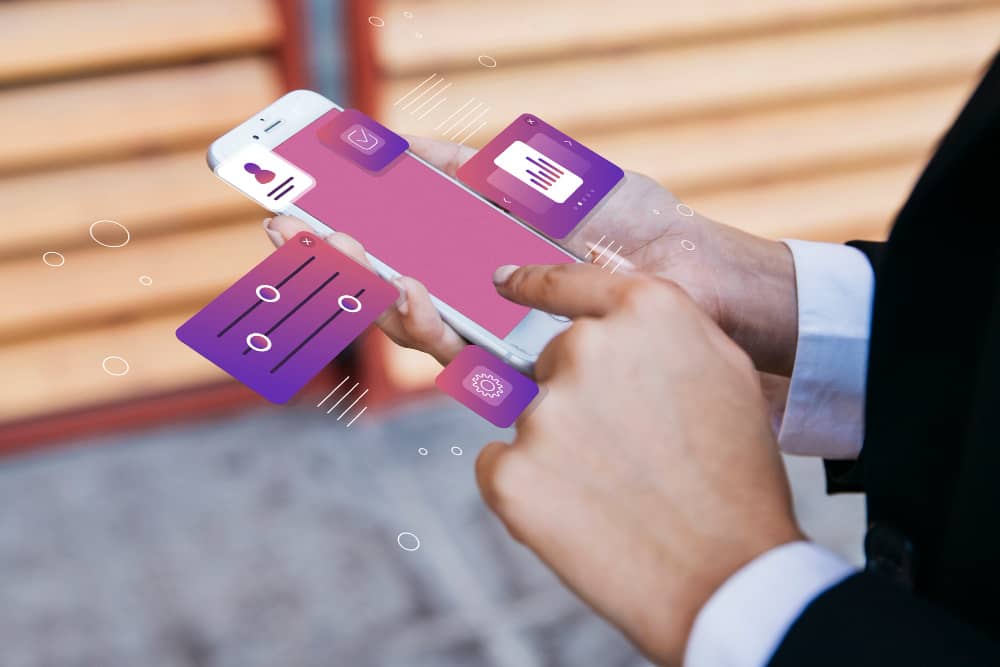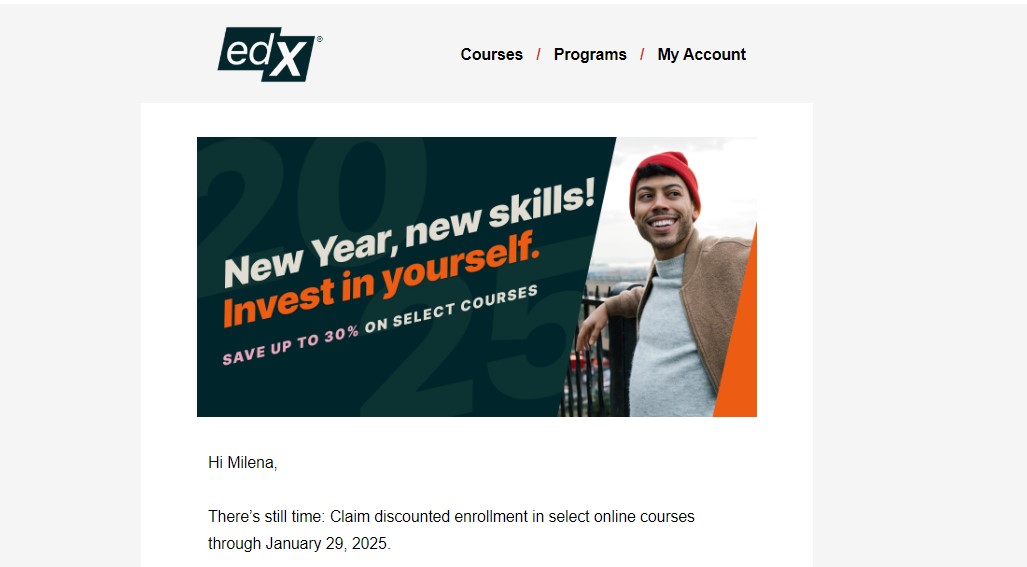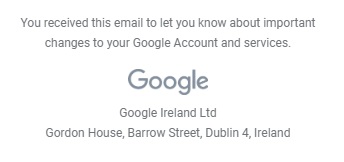It’s a fact: email marketing is one of the most effective digital channels to reach leads, customers, and audiences. However, many marketers mainly focus on the email body and often overlook and treat microcopy as a secondary or even as a non-essential aspect of the whole package. This is a grave mistake because microcopy in email marketing has the power to persuade, convert, guide, reassure, and so much more.
Curious about how to make the most of microcopy for maximum impact? Keep reading to learn more.
What Is Microcopy in Email Marketing?
Microcopy in email marketing is very short and highly impactful text that appears in various strategic positions in marketing emails. Lengthwise, it can be even just two words long, but that depends on it’s purpose and placement. And, depending on its positioning in the email, microcopy can give readers more guidance and insights about the text they’re consuming or the next steps they need to take.
With conversions being such a major strategic email marketing key performance indicator (KPI), microcopy shouldn’t be ignored. A few examples of where it is normally found include subject lines, preheaders, calls to action (CTAs), error correction emails, footers, and more.
Microcopy, as opposed to regular email copy, is, therefore, the small/short text elements in a marketing email that help readers and audiences act. It can be persuasive, encouraging, engaging, comforting and/or reassuring, explanatory, and more, offering meaningful information in short bursts to help readers navigate an email better.
Why Is Microcopy Essential in Modern Email Marketing?
Crafting microcopy indicates that you’ve put a lot of thought and effort into improving your user experience (UX) and reducing any levels of uncertainty that users may have. It also gives them more confidence to take certain actions. Overall, microcopy can significantly contribute to your email campaign’s success.
In short, a few of the advantages include:
- Enhancing the user experience (UX) and reducing decision friction
- Driving specific actions with minimal effort (e.g., clicks, signups)
- Increasing engagement, conversions, and overall campaign success
Key Microcopy Areas to Optimize
Microcopy in email appears in several strategic places. The following seven have been chosen as the most critical ones. Let’s explore them in some detail below.
1. Subject lines and preheaders
What and where: The email subject line is the first textual piece of information the reader sees when they receive your marketing email in their inbox. The email preheader text plays a supporting role in the email subject line. Both elements aim to entice the reader to open the email and read more. Both, therefore, play an important role in grabbing attention and boosting open rates.
Best practices: Focusing on using personalization, creating a sense of urgency or a fear of missing out (FOMO), and encouraging curiosity.
- Example #1:
- Subject line: Unlock Exclusive Deals Just for You
- Preheader: Your personalized discounts are waiting—don’t miss out!
- Example #2:
- Subject line: Your First Look at Our New Collection
- Preheader: Fresh styles have just arrived. See what’s trending now.
- Example #3:
- Subject line: Flash Sale Alert: 24 Hours Only
- Preheader: Get your favorites at a steal. Hurry, time’s ticking!
- Example #4:
- Subject line: Need a Midweek Pick-Me-Up?
- Preheader: Special offer inside to brighten your day.
- Example #5:
- Subject line: Ready for a Summer Adventure?
- Preheader: Gear up with our essentials. Here’s where to start.
2. Header image text
What and where: The microcopy on the header image is the short text on your campaign’s main image in the email body. It should be concise, visually engaging, and attention-grabbing.
Best practices: Use bold, clear statements and/or eye-catching slogans such as your overall campaign slogan. The more visibility this slogan gets in follow-up emails and through other channels, the more memorable it will be. Ensure the text in your images is very short, direct, and easy to read and understand. This text can be used in other images as well, but ideally not in the same email so as not to become too visually overwhelming. And lastly, the header image text or microcopy should align with your subject line and theme of the email/campaign to create a cohesive message.
Examples:
- Get 50% Off Today Only!
- Limited Time Offer – Shop Now!
- Can’t find the right fit?
Bonus tip: Don’t be afraid to pose short questions to create a conversational flow as well as interest in your text.
3. First sentence of the email body
What and where: The first sentence should immediately capture the reader’s attention by addressing their pain points, needs, or desires. The opening line also sets the tone for the rest of the email message to follow, depending on the context and goal in question. Titles can also enhance readability and attract attention in emails.
Best practices: Be short, clear, punchy, and relevant. And importantly: make the text personal and benefit-driven.
Examples:
- Questions: Looking for the perfect tool to boost your productivity? / Need a quick fix for your haircare routine?
- Bold statements: The sale you’ve been waiting for is finally here! / This is a deal you won’t find anywhere else!
- Personalization: Hey [Name], we found something you’ll love! / The perfect gift is just a click away, [Name]!
- Problem-solution: Stuck in a digital clutter? Let us help you organize! / Running out of ideas? We’ve got something perfect for you.
- Urgency: Act fast, this deal won’t last long! / Only a few hours left to grab this amazing offer!
- Stories: Want to know how our customers saved big on their last purchase? / Picture this: Your shopping cart is full, and so is your savings account.
- Benefits: Shop smart, save big, and enjoy it all! / Unlock discounts and rewards on every purchase.
4. Bulleted/numbered lists
What and where: Lists are great for organizing information clearly, making it easier for readers to digest key points quickly. They appear in the body of a marketing email or could even appear in an image for stronger branding. They present information in easy-to-scan ways so that the most important information can be extracted at a quick glance.
Best practices: Keep your list of items brief and to the point. Use bullets for unordered information and numbers for steps or rankings.
Examples:
- Product benefits
- What’s new or recent updates
- Newsletter previews
- The sequence of steps to activate a tool, software, or program
- How to participate in an event (e.g. join a webinar or enter a competition or giveaway)
5. CTA microcopy: Driving the click
What and where: The call-to-action or CTA button is your conversion machine. It can appear in strategic places in your marketing email and should use action-oriented and emotionally engaging language.
Best practices: The CTA should use specificity, scarcity, and social proof. In most cases, it should comprise a minimum of two words and a maximum of five. In some cases, one word is sufficient, but this will depend on the context. All in all, the shorter—the better.
Examples (with bolded CTAs):
- Get the look everyone’s talking about — Shop the style!
- See why thousands of people love our product — Read reviews!
- See how we helped [Brand Name] boost sales by 30% — Read the Case Study.
Other examples:
- Subscribe Now
- Register
- Submit
- Learn More
- Shop Today
- Join Free
- Get Started
- Claim Your Offer
- See Details
- Discover More
- Try It Now
- Read the Full Story
6. Footer microcopy: Building trust and retaining engagement
What and where: Footers appear at the bottom of marketing emails and contain information that may not be directly essential to your campaign’s marketing message but nevertheless plays a key role.
Best practices: Consider using email footers for subtle engagement prompts, such as social links and feedback requests. You can also use the opportunity they afford to enhance trust with transparency. For instance, this is where you can position your privacy statements or opt-out options in a considerate way without having your microcopy result in negative sentiment or emotions.
Examples:
- Stay connected with us on social media for the latest updates and exclusive offers.
- We’re here to help—contact our support team anytime at [email/global phone number].
- Thank you for supporting our mission to [briefly state mission or cause].
- Update your preferences or unsubscribe at any time by clicking here.
- You’re receiving this email because you signed up on our website. Manage your subscription here.
7. Error messages and form microcopy
What and where: Use every opportunity to connect with your audience. Even when things don’t go as planned. A perfect example is when a user is taken to a page that displays an error message. Another case is when your users are required to fill out a form.
Best practices: In such cases, focus on reducing user frustration with helpful and friendly error messages. As for forms, guide your users through short and unambiguous steps and clear and concise instructions.
Examples:
- Error message: Oops! That email doesn’t look right. Please enter a valid email address like name@example.com.
- Form field helper text: The password must be at least 8 characters, including a number and a special character.
- Error message: Something went wrong. Please try again later or contact support if the issue persists.
- Form field placeholder text: MM/DD/YYYY
- Confirmation message: Almost there! Check your inbox to confirm your subscription.
Tips for Optimizing Your Microcopy in Email Marketing
Optimizing your email marketing microcopy and testing new strategies is vital for success. Here are a few ideas to consider.
1. Mobile-friendly microcopy: Adapting for small screens
With billions of people around the world carrying a smartphone, it follows naturally that they’ll receive marketing emails in their mobile inboxes, too. That’s why it’s essential to write microcopy that is adapted to mobile devices.
A few challenges worth noting for mobile email marketing include the limited space available with which to grab attention and users’ short attention spans. This means your microcopy must be razor-sharp and get to the point as quickly as possible.

2. The role of A/B testing in microcopy optimization
Another wise move would be to perform continuous testing to find out what resonates with your audiences best. Experiment with different components, including subject lines, preheaders, CTAs, and error messages. Furthermore, when learning how to segment email lists effectively, you can test different elements on various audience segments.
Bonus tip for CTAs: When it comes to A/B testing in email marketing, avoid changing everything on your CTA button at once. Instead, focus on making small, incremental changes to aspects such as the wording, button size, font size, colors, etc., individually or one at a time. See the impact of each small change and make light changes for the best possible outcomes.
3. Advanced microcopy tips for maximum impact
As for some advanced microcopy tips, it’s worth knowing that there are tools that can help you create dynamic microcopy, which adapts content based on user behavior in real time.
Furthermore, you can incorporate microcopy in various interactive elements such as GIFs and videos in email marketing. However, be aware that most email hosts still do not currently support videos.
Finally, it’s essential to determine what type of return on investment (ROI) you are achieving on your email marketing campaigns. The best way to do this is to leverage the power of analytics. This has a dual function: one is to help you refine your microcopy over time, and the other is to help you make data-driven decisions for optimal results.
Microcopy in Email Marketing: Conclusion
It’s undeniable that microcopy can drive your email marketing campaign’s success. But getting it right can take time and effort as you continuously refine your approach.
As key takeaways, it’s highly recommended that you always prioritize clarity, test consistently, and embrace creativity while adhering to your brand guidelines.
Ultimately, you should experiment with caution and continue to refine your microcopy for ongoing improvement.





